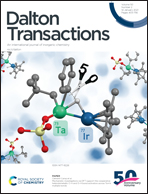MOFs assembled from C3 symmetric ligands: structure, iodine capture and role as bifunctional catalysts towards the oxidation–Knoevenagel cascade reaction†
Abstract
Three new NiII/CoII-metal organic frameworks were self-assembled by the reaction of C3 symmetric 1,3,5-tribenzoic acid (H3BTC) and 2,4,6-tris(4-pyridyl)-1,3,5-triazine (4-TPT) ligands and NiII/CoII salts under solvothermal conditions. Isomorphous MOF1 and MOF2 exhibit a 3D pillar-layer framework based on binuclear M2(OH)(COO)2 units connected by tritopic BTC3− and 4-TPT ligands with a novel (3,5)-connected topology net. MOF3 displays a 3-fold interpenetrated 3D network exhibiting a (3,4)-connected topology net. The porous MOF3 can reversibly take up I2. The activated MOFs contain both Lewis acid (NiII center) and basic (uncoordinated pyridyl or carboxylic groups) sites, and act as bifunctional acid–base catalysts. The catalytic measurements demonstrate that the activated MOF3 exhibits good activities for benzyl alcohol oxidation and the Knoevenagel reaction and can be recycled and reused for at least four cycles without losing its structural integrity and high catalytic activity. Thus, the catalytic properties for the oxidation–Knoevenagel cascade reaction have also been studied.



 Please wait while we load your content...
Please wait while we load your content...